I was lucky when I bought this Canon 7SZ together with a Canon 3.5/135mm LTM lens at an Internet auction site for just $171. I say lucky because
collectiblend values the body alone at $340-$900. But that's not all. Because Canon produced just 4,000 of them, the 7SZ is considered
scarce and highly collectible. And, to make the deal even better, this unit is in excellent condition.
Manufactured from 1967-1968, the Canon 7SZ is similar to its near twin, the Canon 7S (not shown). Both cameras feature metal shutters; both are labeled 7S (there's no logic to this); both require batteries to operate their exposure meters; and both have outer bayonet mounts for the legendary Canon .95/50mm lens. The 7SZ, however, has a larger rewind knob. Because I'm not technically oriented, I don't know if other differences exist between the two cameras.
As you would expect, these two cameras require outlawed mercury batteries to activate their meters. Believe it or not, my 7SZ came with one that still had life in it. If I were planning to use the camera, I suppose I'd have to find an alternative to the mercury battery soon. But I think my Canon 7SZ #121750 will spend eternity in my display cabinet.
Between 1961 and 1965, just a few years before they produced the 7S and the 7SZ, Canon

introduced the Canon 7 (photo right). Seen from the front, the 7 bears a close resemblance to its cousins. The cameras share the same body, viewfinder window, self timer, and LTM/Bayonet mount. Like the 7SZ, the Canon 7 features a metal shutter.
The two cameras differ, however, in the 7's rectangular light gathering window that serves its selenium light meter as opposed to 7SZ's circular eye.
Although most of these more-than-fifty-year-old cameras have wrinkled shutters, the one shown here does not. I suppose that would make it more desirable than many others. By the way, if they're not too badly damaged, wrinkled shutters don't affect the operation of these cameras.
Seen from the top, the differences between the two cameras are obvious. Because the Canon 7 (red dot) features a selenium exposure
meter, its meter window differs from that of the 7SZ. The 7 also has a

rewind knob and lever that's smaller than that of the 7SZ, as well as a protuberance in front of the shutter release button to contain the camera's plastic bubble window for its exposure meter. The 7SZ, by contrast, mounts an accessory shoe, which is lacking on the 7.
That said, the field of view adjusting dials next to the rewind knobs on both units provide for the same 35, 50, 85, 100, and 135mm views and are identical in appearance. The film speed dials, shutter release buttons, film counters, and film advance levers are twins as well. Both cameras have those little telltale circular windows with red dots that revolve when you advance the film...a nice touch.

Viewed from the back, you can see a small dial to the right of the Canon 7's (red dot) eyepiece . That's the high range-low range switch. Just above the switch there are two tiny screws. If you know the purpose of those screws, please let me know.
On the 7SZ you can see a somewhat larger dial below the black shutter speed dial. That's the battery check/on/ off switch.
Other than those differences, the backs of the two cameras are identical.
Are you wondering what those two little buttons to the left of the names and serial numbers of both cameras are for? Well, they're spring loaded gizmos that you depress to change the ASA settings on the camera's shutter speed dials.
If I had my druthers, which of these two excellent cameras would I prefer? For me that's a no brainer. Because I don't like to rely on a battery operated meter; because I have no need for an accessory shoe; and because I've never used a flash unit for my mostly outdoors photography, my choice would be the Canon 7.


In the past I used this more than fifty-year-old camera for street photography in New York City. The lens I used was a Russian 2.8/53mm Industar-61 lens (see "What about Those Russian Lenses?"). Here are two samples of the images it produced. As I recall, these were quick grab shots at
f11 1/250 with the camera pre focused at 10 feet. I think I was using Kentmere film for both photos.
COMING SOON: The Canon VT














































